The Use of Cannabidiol as a Potential Treatment to Reduce Fear Aggression in Cats
Aline Loutfi1, Dima Mnayer2* and Hala Mounayar1
1Faculty of Agricultural Engineering and Veterinary Medicine, Lebanese University, Dekwaneh, Beirut 6573, Lebanon
2Faculty of Health Sciences, Nutrition Department, University of Balamand, Lebanon
Submission: August 16, 2024; Published: August 30, 2024
*Corresponding author: Dima Mnayer, Faculty of Health Sciences, Nutrition Department, University of Balamand, Lebanon. Email: dima.mnayer@balamand.edu.lb
How to cite this article: Aline Loutfi, Dima Mnayer* and Hala Mounayar. The Use of Cannabidiol as a Potential Treatment to Reduce Fear Aggression in Cats. Dairy and Vet Sci J. 2024; 17(1): 555953..DOI: 10.19080/JDVS.2024.17.555953
Abstract
The cannabis plant has been used for thousands of years for both its recreational and medicinal purposes. Preclinical and clinical studies suggest that Cannabidiol, which is one of many cannabinoid compounds found in Cannabis Spp., has broad therapeutic value. One potential application that has attracted considerable interest is the treatment of stress and anxiety related disorders. A recent wave of scientific publications has found evidence documenting the value of CBD in several neuropsychiatric disorders including anxiety. The purpose of this study was to determine if CBD affects stress related behavior in cats. The sample consisted of 28 cats divided into 2 groups that were created by assigning the cats alternately: 18 cats were assigned to the treatment group and 10 to the control group. CBD oil of 15% mixed with olive oil was given to the treated group; the placebo group consisted of olive oil only, dispensed twice daily for 3 days. A single dose was given to all cats regardless of cat’s weight, 15 – 20 mg/cats twice daily, which is equivalent to 4 drops twice daily. Cats were exposed to two types of stressful situations, car transportation or exposure to blower. Data included changes in heart rate, respiratory rate, behavioral changes as well as the sedative effect of CBD. Data were collected at the T0 before administering the drug and at Tf after 3 days of treatment. Treated cats showed decrease in heart rate (repeated measure ANOVA: p = 0.000219) and decrease in respiratory rate (repeated measures ANOVA: p = 0.000120). In addition, this study showed that CBD can have some sedative effect on cats. However, only a few cats showed no signs of distress during stimulus exposure on the last day of treatment. These findings suggest that it is worth doing more research to further investigate the effect of CBD on cat’s behavior.
Keywords: Cannabidiol; CBD; Cats; Fear; Stress
Abbreviations: THC: Tetrahydrocannabinol; CBD: Cannabidiol; ECS: Endocannabinoid System; FAS: Fear Anxiety Stress; PVP Pre-Visit Pharmaceutical; HR: Heart Rate; RR: Respiratory Rate; ECG: Electrocardiogram
Introduction
Dating back to ancient times, the cannabis plant has been used widely both for its medical and psychoactive effects, in human as well as in veterinary medicine. Cannabis Sativa and Cannabis indica are the 2 main species [1,2]. The plant contains a mix of cannabinoids with two principal components found at highest concentrations. The first one is Δ9-tetrahydrocannabinol (THC), also known as “marijuana”, responsible for the psychotropic and toxic effects, in humans and animals. However, the second is Cannabidiol (CBD), referred to as “hemp”, has no psychoactive and has low toxicity [3,4]. CBD has been known to treat several disorders [5,6]. The first evidence of cannabis cultivation appears to be in China in 4000 BC, where it was used to treat malaria, menstrual symptoms, gout and constipation. Analgesic, anticonvulsant, anti-inflammatory and antibiotics effects were among the diverse medical indications during medieval times, both in Arabic and South American medicine [7,8]. In addition, hemp has been cultivated for thousands of years, for their high level of fibers and CBD that can be used to make oil, fabric, food and rope [9,10]. However, restrictions were made until the use of cannabis was completely stopped in 1970, claiming it an illegal substance with no medical values. Despite that, California State was the first to go against the federal ban and provided cannabis for medical uses [11,12]. Currently, to be considered legal, industrial hemp must contain less than 0.3% THC [13,14].
CBD interacts in the body through the endocannabinoid system (ECS) [15]. It has been found that nearly all animals, including vertebrates and invertebrates, have endocannabinoid systems. The ECS plays a critical role in the main biological process responsible for pain, mood, sleep, memory and more [16]. This system is also involved in maintaining hemostasis for different organs and in modulating the nervous and immune systems through different receptors. Cannabinoid receptor 1 (cb1) and cannabinoid receptor 2 (CB2) are the two principal receptors. It was found that CBD is an agonist for serotonin 1A (5-HT1A) receptors, which is associated with mood and stress, through the interaction with serotonin [17,18].
Stress is the body’s response to pressure. Many different situations or life events can cause stress. For most cats, going to veterinary clinics is an overwhelming experience and a stressful event, due to several stressors starting by being roughly pushed into a carrier, transported in a noisy car, being taken into an examination room where an unfamiliar person examines them and gives them various treatment. Fear or aggression can occur when cats perceive a threat, and it increases if they can’t escape. A study by Mariti et al. [19] showed that 59% of cats were reported to exhibit signs of distress during car travel and 66% during veterinary visits. For this reason, there was a concern that most of the time, cats lack both preventive and acute veterinary care to avoid stress [20]. In addition, behavioral problems are still one of the causes that lead to abandonment and euthanasia [21].
Behavioral problems in cats are not only harmful to a patient’s mental health, but as well it can affect a patient’s welfare, diagnosis and treatment. Because, when anxiety strikes, the body initiates a stress response “fight or flight”, in which stress hormones such as adrenaline and cortisol are released. This response, is an expected and adaptive mechanism that makes an animal ready for activity or defense, however, it also has bad repercussions on a number of physiological parameters, including heart rate, respiratory rate, temperature, and blood pressure...making it very difficult to perform an accurate medical examination Ligresti A. [22], Aggressive cats make veterinary examination difficult for staff as well, who may be cut or bitten by agitated and aggressive cats [23].
So far, the main pharmacological treatments for anxiety disorders include benzodiazepines, tricyclic, selective serotonin reuptake inhibitors... However, these pharmacotherapies tend to have adverse effects and low efficacy as well as being expensive, limiting their usage in veterinary medicine. Therefore, there is a strong and urgent need to develop new treatment approaches for fearful behavior. CBD products have become increasingly popular in recent years. And since there is a lot of discussion regarding the benefit of CBD oil both in human and dogs, cats are usually left out of the CBD conversation. Until now, no study has evaluated the influence of CBD products on cat aggression. This study is a clinical trial, and the aim is to investigate if CBD oil when used at specific dosage, few days before transportation to clinic, can decrease stress behavior in cats and ease their handling during examination and grooming.
Material and Methods
This study was performed at Animal Life Veterinary Center- Khaldeh, mainly on cats that were staying at the clinic, whether for adoption or for boarding, allowing a better observation during the study. Apart from the 3 cats that were being treated at home by their owner. The material used is CBD oil 15% provided by another Veterinarian for the purpose of this study only.
Animals and housing
The subjects of this study were 28 domestic cats, including 18 cats belonging to the treatment group and 10 cats belonging to the control group. Aged between 1 and 6 years (average 2.75 years), weighing between 2.4 and 5.7 kg (average of 3.97 kg). Criteria for the selection compromised cats that are physically healthy and show no signs of illness and reveal various kinds of behavioral problems after being exposed to stress (e.g., blowers during grooming or transportation). Among the 18 cats belonging to the treatment group, 15 cats were located at the clinic during the study. These felines were kept in [1.5 m] ^2 sized cages, with food and water available ad libitum, maintained at ambient temperature. The cages were cleaned twice a day, before food distribution. The remaining 3 cats were treated at home with their owners giving the drug. Whereas the 10 cats belonging to the control group were all located at the clinic during the study time.
Stress level assessment
To assess stress levels in cats, the Fear Anxiety Stress (FAS) scale was used. The FAS scale is a 5-item behavior assessment that identifies a cat’s comfort level with people, it helps veterinarians to understand when to stop examination before it becomes dangerous, based on cats’ body language. Level 0-1, pets are relaxed and readily accept treats, which allows veterinarians to perform examinations easily. Level 2-3, pets show no interest in treats, they are fidgeting and have settling difficulties, and sometimes may require pre-visit pharmaceutical (PVP), a term used to describe anti-anxiety medication to help ease a pet experience with vet visits or other stressful events). Level 4, pets who are not willing to participate in procedures and may attempt to get away, and may exhibit fight, flight, or freeze responses, sedation may be recommended or rescheduled with PVP. Level 5, pets show signs of aggression such as hissing, snapping and lunging, at this level sedation is a must. The selected cats showed signs of level 4, where the pet was not willing to participate in procedure and may attempt to get away or escape, plus some were hissing, have continuous vocalization and enlarged pupils... except for one cat called Gingy who exhibited signs of level 5 (Table 1).
In addition to body language changes, studies have shown that stress can increase heart rate and oxygen demand which in turn lead to increased respiratory rate. After the brain process signals of acute stress, the sympathetic system stimulates the adrenal gland, triggering the release of adrenaline and cortisol, which in turn results in an increase in heart rate, blood pressure and breathing rate. In addition to body language evaluation, in chosen cats, heart rate and respiratory rate were also calculated (Table 1).
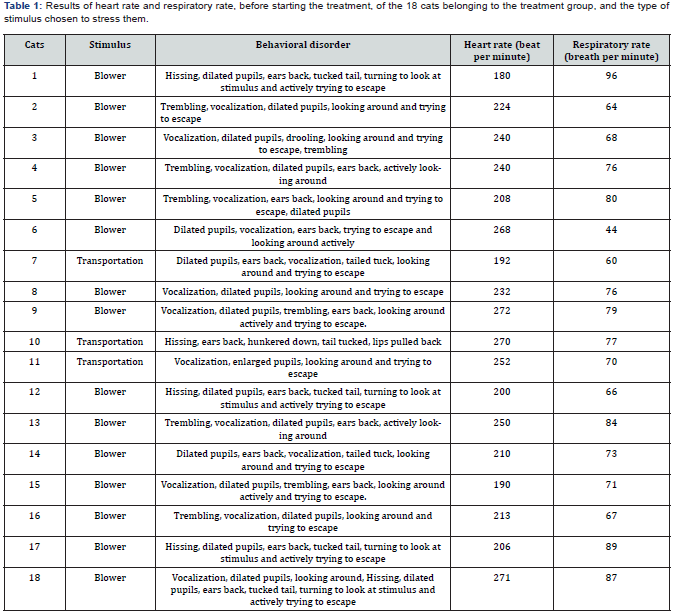
Treatment
Behavioral assessments and health checks were performed prior to the start of the study. If eligible, cats were exposed to a stressful event, such as car transportation or turning the blower on their face. After cats show signs of distress and fear, heart rate and respiratory rate as well as behavioral disorder for each cat were documented. After that, cats received treatment for three consecutive days, followed by reassessment.
The cats belonging to the treatment group were given CBD based oil while cats belonging to the control group were given a placebo. The product used was broad spectrum CBD oil of 15% in 10 ml solution. Which means that the solution contains 1500 mg of CBD per 10 ml oil thus 150 mg/ml. Every ml was equivalent to 15-20 drops. Therefore, the solution contains 150 mg of CBD in every 15-20 drops corresponding to almost 7.5-10 mg per drop. The product was diluted with 10 ml of olive oil to have a higher volume but lower concentration leading to 3.75-5mg per drop. Cats received 4 drops equivalent to 15-20 mg twice daily for consecutive 3 days, plus one single dose on the 4th day. The dosage was selected based on a previous clinical study performed by a senior veterinarian. The placebo consisted of olive oil only. With or without CBD, the oil administration did not require any kind of interaction since the oil was mixed with wet food.
Assessment
Regular checkups on cats were conducted for the first 30 minutes after administration of CBD based oil or the placebo to make sure that cats ate the wet food offered to them containing the oil. Followed by observation every few hours daily during the 3 days, to see if there are any behavioral changes. Categorical scales were used in the assessments. To assess any behavioral changes and the potential sedative effect during the 3 days of treatment, the cat’s activity was scored as “very calm/sleeping”, “calm”, “neutral”, “active”, or “very active”. Along with, observations were made to detect the presence of any kind of adverse effects, including vomiting, diarrhea, drooling.
At home, owners were also asked to make sure that their cat was eating the offered wet food containing the drug and to keep an eye on the cat to see if there are any changes, whether its behavioral or not, and to call the clinic whenever they suspect that their cat is having any kind of side effect or toxicity. At the final day, and 30 minutes after making sure that the drug was fully ingested, cats were exposed to the same stimulus (car transportation or blower). After observing the change in behavior during exposure, heart rate and respiratory rate were taken as well by using Heine Gamma 3.2 stethoscope. The signs of distress, anxiety and/or fear during exposure to stimulus, included hissing, dilated pupils, ears back, tucked tail, turning to look at stimulus and actively trying to escape, trembling, vocalization... The severity of these signs was rated each as “absent”, “mild”, “moderate”, or “severe”.
Statistical analysis
Heart rate (HR), respiratory rate (RR) and behavioral changes were the targets of this study. The collected data at the beginning (T0) and the end of the study (Tf) were entered and analyzed using Statistica Version 14 computer software. First, to analyze the difference between heart rate and respiratory rate independently, between T0 and Tf, for the control and the treatment groups separately, dependent t-test was used. However, to compare the difference between treated and placebo groups, repeated measures analysis of variance (ANOVA) was utilized. To compare behavioral changes between the beginning and the end of the study, Pearson’s chi-square test was used to describe the sedative effect of the drug during the three days of treatment and the presence and the severity of signs of distress in the time of stimulus exposure in the last day of treatment. Differences were statistically significant with p <0.0
Results
Eighteen cats were enrolled in this study. Fourteen were male and the other 14 were females. Their median age was 2.75 years (1 to 6 years), and weight was 3.97 kg (2.4 to 5.7 kg). Since this study does not analyze the effect between CBD and if the cats were neutered or not, the latter was not taken into consideration. No feline showed disease symptoms during the study as written in the literature. Cats tolerated well olive oil either with or without the addition of CBD. The experienced results of each group have been obtained using independent t-test as seen in table 2, as it shows the heart rate and respiratory rate, at T0 and Tf, and their average.

Interpretation of results was devised to compare each group using one way ANOVA to study the differences and relation of each parameter. More tables and figures describing the results within each parameter will be analyzed and interpreted in detail.
Heart rate results
In the treatment group, there was a significant difference in heart rate between the beginning of the study (HB1) and at the end (HB2) (Figure 1). This result shows that at T0 the highest heartbeat recorded was 272 beats per minute and the lowest was 180 beats per minute. At the end of the study these results decreased where the highest score became 256 beats per minute and the lowest was 140 beats per minute.
However, due to the administration of olive oil without CBD, there was not a huge difference in heart beats between HB1 and HB2. Figure 2 shows a huge overlap. Where the highest heartbeat in T0 was 265 beats per minute and the lowest was 198 beats per minute. The results did not change at Tf, where the highest score recorded 245 beats per minute and the lowest remained 198 beats per minute.
The cross effect between heartbeat and treatment illustrates the difference between different treatments on heartbeat at T0 and Tf. It shows that when olive oil was mixed with CBD, the heartbeat has significantly decreased between the two-time intervals (Figure 3)
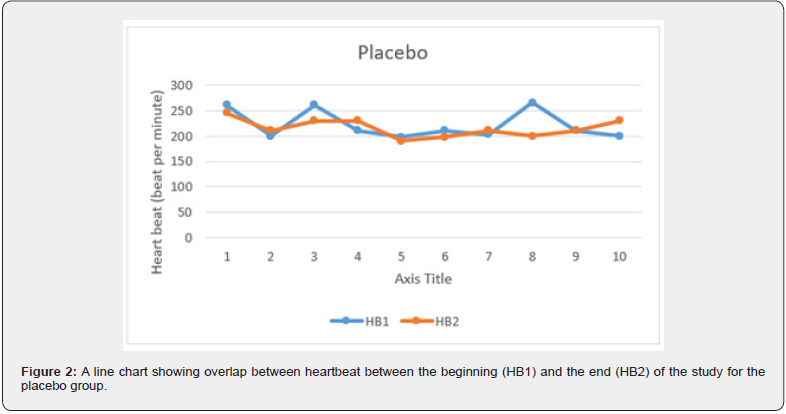
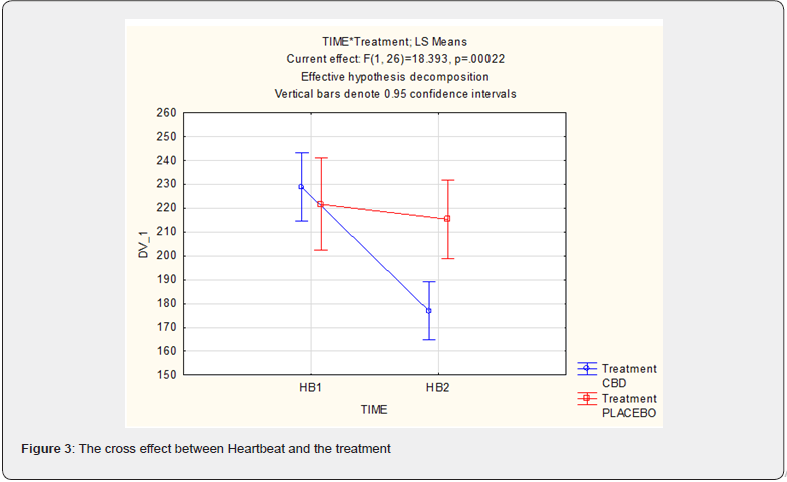
Repeated measures ANOVA was used to analyze the difference in heartbeat between treatment and placebo groups. The effect of treatment in two different times (T0 and Tf) is shown in table 3. According to the table, the treatment effect is not significant (p = 0.11), however the heartbeat (p = 0.000019) and the cross effect between heartbeat and treatment (p = 0.000219) show significant results.

Respiratory rate results
Regarding the respiratory rate, in the treatment group 3 cats maintained the same respiratory rate in T0 and Tf. However, for the remaining 16 cats, there was a significant difference between in T0 and Tf, where scored P = 0.05 (Figure 4).

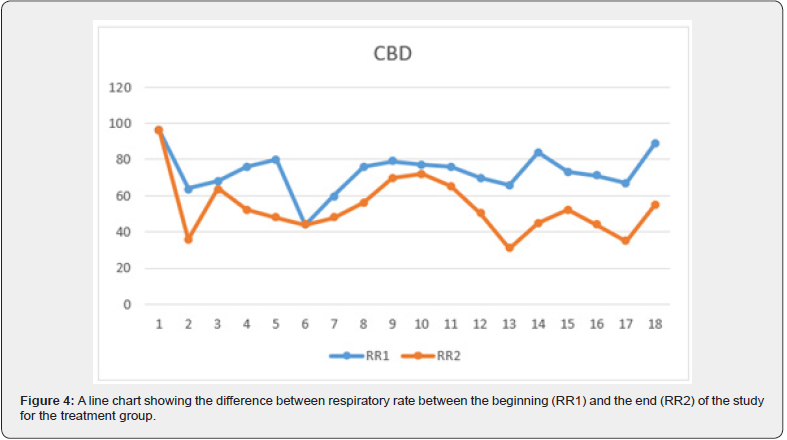
While in the placebo group, figure 5 shows a huge overlap between T0 and Tf. The respiratory rate of each cat did not change much comparing the beginning and the end of the study.
To analyze the difference in respiratory rate between different treatments, repeated measure ANOVA was used as well, the result is presented in table 4. As found in the table, the treatment, respiratory rate and their cross effect, the three of them show significant results according to p (in all the three effects p scored < 0.05).
Figure 6 represents the cross effect between the respiratory rate and treatment. It shows that when olive oil was mixed with CBD, the number of breaths per minute decreased between T0 and Tf, when the cats were exposed to the same stimulus.
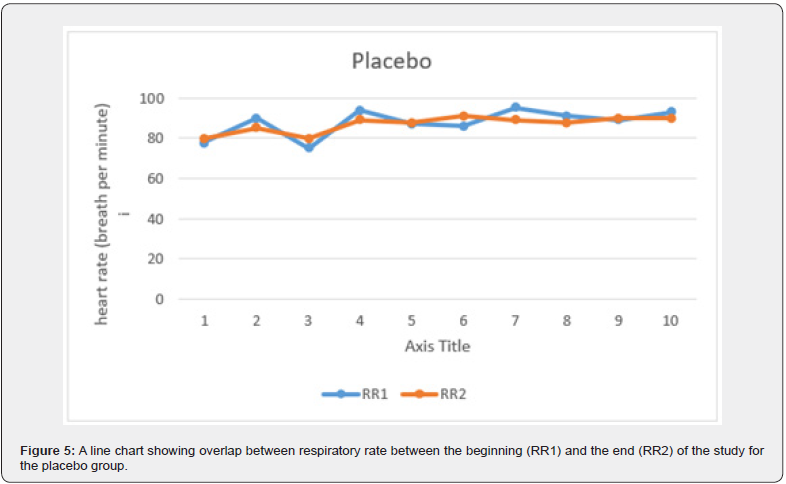
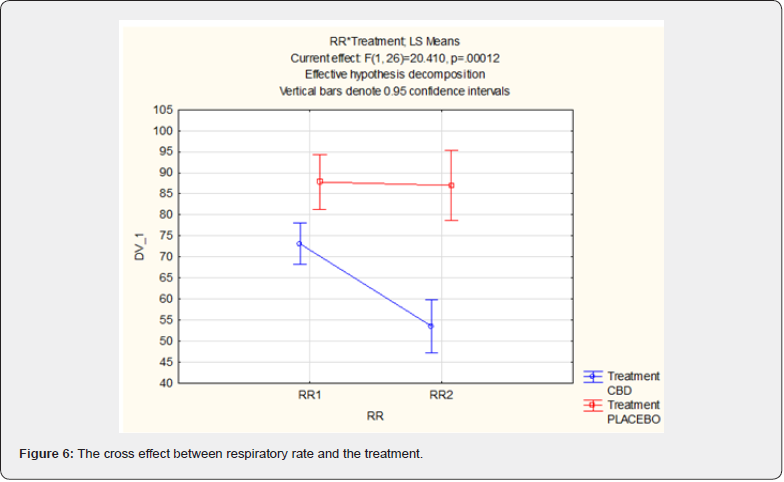
Behavioral changes
To compare the behavioral changes in this study, two parameters were chosen. First the sedative effect while giving the treatment and the other one was the presence of emotional stress in those cats at the end of the study as defined in the FAS scale. To do this Pearson’s chi-square test was used.
At first concerning the sedative effect throughout the treatment, figure 7 shows that while giving the olive oil without the CBD (the placebo group), 50% of the cats (5 cats) remained active and 50% (5 cats) were described to be very active, no cat showed neutral, calm or sleeping effect. In contrast, when olive was given with CBD, no cat remained active. In fact, 22.22% (4 cats out of 18) remained neutral, while 50% (9/18 cats) were calm during the treatment, however 27.78% (5/18 cats) scored “sleeping” during the three days.
On the other hand, while studying the association between treatment and the distress signs at Tf when cats were exposed to the same stimulus they were exposed to at the beginning, figure 8 shows that 100% of cats (10 out of 10) reveal a very severe distress reactions at Tf in the placebo group. Which means that olive oil without CBD had zero effect on decreasing fear, anxiety and stress level in cats. By contrast, while administering CBD, different reactions were present. 44.44% (8 out of 18) of cats experienced mild signs of distress, 11.11% (2 out of 18) showed moderate signs, 38.89% (7 out of 18) didn’t have any distress signs while being exposed to stimulus and only 5.56% (1 out of 18) showed severe distress signs.
Discussion
Prescription and non-prescription Cannabis use has increased significantly over the past decades, reflecting a shift in Cannabis policy toward a more permissive stance. There is evidence that Cannabis works as an alternative to prescription drugs. Preclinical and clinical studies suggest that Cannabidiol, which is one of many cannabinoid compounds found in Cannabis Spp., has broad therapeutic values, including analgesic, antioxidant, antiinflammatory, and anti-anxiety effects. Despite popular belief that CBD is a safe and effective treatment for these conditions, the lack of scientific clarity regarding CBD safety, dosage, and efficacy in both humans and pets is important for further research.
This present study is one of the first to describe the effect of CBD on the fear and anxiety response of cats. Fear and anxiety are adaptive responses essential to coping with threats to survival. There are many situations in which cats get nervous including getting into the carrier or trips to the vet or groomer. A study by Mariti et al. [19] showed that 59% of cats were reported to exhibit signs of distress during car travel and 66% during veterinary visits. For this reason, there was a concern that most of the time, cats lack both preventive and acute veterinary care to avoid stress [20]. Moving to a new home, adjusting to a new cat and people around the house, traveling, visiting the vet or groomer, there are many situations that can make a beloved kitty nervous. Aggressive cats make veterinary examination difficult for staff as well, who may be cut or bitten by agitated and aggressive cats [23]. The fear response in this study was measured by placing cats in stressful situations. The two main frustrating environments that were used in this study were either car transportation or exposure to blower.
Daily monitoring of the observed health status of the cats allowed us to assess and evaluate any pathological responses to olive oil, CBD, or both. Given that it occurs, we can conclude that olive oil treatment was well tolerated with and without CBD. No gastrointestinal or constitutional side effects were observed in cats that received CBD during this study. Additionally, food intake and body weight remained constant throughout the experiment. However, studies evaluating the safety of oral CBD administration to cats have reported possible side effects such as gastrointestinal problems such as vomiting and diarrhea, and hematologic changes such as increased liver enzymes [24]. However no hematological changes were assessed during this study. The potential effects of oral CBD administration on clinical chemistry parameters should be monitored in future studies, as elevated liver enzymes may indicate altered liver function. In addition to adverse effects, since in the literature some information suggests that CBD can build tolerance [24], cats that were chosen in this study did not show any symptom related to CBD intolerance. Moreover, no cat included in this study became dependent on CBD.
However, the major limitation of this study was that it was carried on using the same dosage of CBD, 15-20 mg/cat twice daily for 3 days. Due to the lack of information in the literature about an effective dose for cats, as well as due to shortage in financial support and time trouble, we couldn’t find a dose based on body weight. Despite that, this dosage still gave some results. Thus, further studies are required to determine an effective dose.
Heart rate has been used as a measure of stress and anxiety in several animal species, including cats. It has been suggested that perceiving a situation as threatening or stressful in combination with changes is cardiovascular activity such as increased heart rate can lead to increased feelings of anxiety [25]. Studies have shown that being exposed to emotional or physical stress can lead to the release of hormones. Adrenaline increases heart rate, raises blood pressure and increases energy supply. Cortisol fills the bloodstream with glucose and narrows the arteries. Norepinephrine increases heart rate, releases glucose into bloodstream, and increases blood flow to muscles. However, when the body is under chronic stress, these hormones can negatively affect heart health. A previous study [26], studying the impact of feeding Cannabidiol (CBD) containing treats on Canine Response to a noise-induced fear response, showed that CBD is unable to decrease plasma cortisol concentration. However, in contrast to all previous studies, in vivo studies showed CBD treatment for 3 days had a significant effect on decreasing heart rate. But the heart rate was measured using a stethoscope because it was difficult to restrain cats from placing an electrocardiogram (ECG). This could have been affecting the results, in which cats after being exposed to a stressful stimulus, felt kind of safe between the hands of the examiner while taking their heart rate using a stethoscope.
Along with heart rate, stress has been as well known to increase respiratory effort leading to increased respiratory rate. The latter was furthermore used to measure the effect of CBD treatment. No previous research has ever studied the effect of CBD in reducing respiratory rate during stressful situations. In this study, results have shown that CBD administration twice daily for 3 days can have some effect on decreasing the respiratory rate. However, in this investigation 3 cats that were included in the treatment group, did not show any changes. Their respiratory rate in the beginning and the end of the study remained the same. Additionally, respiratory rate was also measured using a stethoscope, which could have been influencing the efficacy of results.
To assess behavioral changes in this study, 2 parameters were chosen. The first one is to assess the sedative effect during the days of treatment. As shown in the results, compared with the placebo, the CBD treatment had some sedative effect. In research that was based on humans, CBD users have reported feeling calmer and more relaxed after taking cannabinoids. In this study, most cats in the treatment group exhibited a calm activity during the study time, while the others were either neutral or sleeping. For example, one cat during her first day at the clinic, she was so scared of people and whenever someone approaches the cages to give her food or even to cuddle her, she tried to escape and hide behind the litter box and started hissing, and after the 1st day of treatment the same cat started showing signs of relaxation and she kept sleeping all day even if someone goes near her cage. In addition to another cat, when the care giver tried to give some food before the start of the treatment, the cat tried to escape from the cage, however only on the second of treatment, the same cat was showing a neutral reaction when the same care giver tried to offer her some food, but she avoided him when he tried to cuddle her. In contrast to the placebo group where cats were either active or very active and whenever someone approaches the cages, cats always showed some signs of fear. These results suggest that CBD can possibly act as a sedative. However, according to some research, CBD’s sedative like effect may be dependent on the dose. And since all cats were given the same dose, this could explain why some cat’s activity remained neutral.
The other behavioral parameter that was chosen to assess the effect of CBD was the level of distress that cats had when they were exposed to disturbing situations. When cats are threatened by something unpleasant or potentially dangerous environment, this naturally triggers the fight or fight response. The cats involved in this study were selected because they showed a flight response which was represented by actively trying to escape, dilated pupils, ears back, whiskers back, tail down and bottle brushed, fleeing and turning to look at stimulus. This is equivalent to level 4 according to the FAS scale. These responses were measured at the last day of treatment to show if cat’s behavior can be decreased by using CBD, allowing veterinary visits to be less harmful for both the cats and the staff. Results show that among all cats treated, only 38.89% exhibit no signs of distress at the end of the study. Whereas the remaining 61.11% still had some distress signs, ranging between mild, moderate and severe.
Conclusion
This study assessed the effects of CBD on cat’s aggression due to veterinary visits. In conclusion, hemp-based CBD appears to be relatively safe in healthy population of cats. Administration of CBD twice daily for three days did decrease the heart rate as well as the respiratory rate for cats. In addition, this study indicates that CBD could have some sedative effects on cats. Such effects may improve the welfare of cats and aid owners in bringing their cats to the veterinarian. However, for behavioral changes during stimulus exposure, CBD different results were present.
Seeing that this study uses a single dose of 15-20 mg/cat, and a stethoscope was used to take the heart and respiratory rates, additional investigations using increased doses of CBD to clarify any potential anxiolytic effect. It is necessary as well to widen the sample of cats and to try to find a dose that is weight dependent. These results pave the way for further behavioral and veterinary studies to understand if CBD could be efficacious also in the treatment of behavioral disorders. Continued clinical follow-up is essential to study the safety of long-term use of CBD. And studies should also examine drug interaction in patients on multiple medications, especially in those that are highly metabolized by the hepatic cytochrome p450 system.
References
- Zlas J (1993) Early medical use of cannabis. Nature 363(6426): 215.
- Baron E (2015) Comprehensive review of medicinal marijuana, cannabinoids, and therapeutic implication in medicine and headache: what a long, strange trip it’s been. Headache 55(6): 885-916.
- Bhattacharyya S (2009) Modulation of mediotemporal and ventrostriatal function in humans by delta9-tetrahydrocannabinol: a neural basis for the effects of cannabis sativa on learning and psychosis. Arch Gen Psychiatry 66(4): 442-451.
- Panlilio P, Goldberg S, Justinova Z (2015) Cannabinoid abuse and addiction: Clinical and preclinical findings. Clin Pharmacol Ther 97(6): 616-627.
- Moreira F, Aguiar D, Guimarães F (2006) Anxiolytic like effect of cannabidiol in the rat vogel conflict test. Prog Neuropsychopharmacol Biol Psychiatry 30(8): 1466-1471.
- Pisanti S (2017) Cannabidiol: State of the art and new challenges for therapeutic applications. Pharmacology & Therapeutics 175: 133-150.
- Zlebnik N, Cheer J (2016) Beyond the CB1 receptor is cannabidiol the answer for disorders of motivation. Annu Rev Neurosci. 39: 1-17.
- McGrath S (2019) Randomized blinded controlled clinical trial to assess the effect of oral cannabidiol administration in addition to conventional antiepileptic treatment on seizure frequency in dogs with intractable idiopathic epilepsy. JAVMA 254(11): 1301-1308.
- Bartner L, McGrath S, Rao S, Hyatt L, Wittenburg L (2018) Pharmacokinetics of cannabidiol administered by 3 delivery methods at 2 different dosages to healthy dogs. Can J Vet Res 82(3): 178-183.
- Resstel L (2009) 5-HT1A receptors are involved in the cannabidiol-induced attenuation of behavioral and cardiovascular responses to acute restraint stress in rats. Br J Pharmacol 156(1): 181-188.
- Bostwick J (2012) Blurred boundaries: the therapeutics and politics of medical marijuana. Mayo Clin Proc 87(2): 172-186.
- Richter G (2020) The endocannabinoid system and phytocannabinoids. Today’s veterinary practice.
- Andre C, Hausman J, Guerriero G (2016) Cannabis Sativa: The plant of the thousand and one molecules. Front Plant Sci 7: 19.
- Riebe C, Pamplona F, Kamprath K, Wotjak C (2012) Fear relief-toward a new conceptual framework and what endocannabinoid gotta do with it. Neuroscience 204: 159-185.
- Roncon C, Biesdorf C, Coimbra C, Audi E, Zangrossi Jr H, Graeff F (2013) Cooperative Regulation of anxiety and panic-related defensive behavior in the rat periaqueductal grey matter by 5-HT1A and μ-RECEPTORS. J Psychopharmacol 27(12): 1141-1148.
- Reimer S, Heritier C, Windschnurer I, Pratsch L, Arhant C, Affenzeller N (2021) A Review on Mitigating Fear and Aggression in Dogs and Cats in a Veterinary setting. Animals 11(1): 158
- Russo E, Burnett A, Hall B, Parker K (2005) Agonistic properties of cannabidiol at 5-HT1a receptors. Neurochem Res 30(8): 1037-43.
- Tateo A, Zappaterra M, Covella A, Padalino B (2021) Factors influencing stress and fear –related behavior of cats during veterinary examinations. Italian Journal of Animal Science 20(1): 46-58.
- Mariti C, Guerrini F, Vallini V, Bowen JE, Fatjó J, Diverio S, (2017) The perception of cat stress by Italian owners. Journal of veterinary behavior 20: 74-81.
- Volk J, Felsted K, Thomas J, Siren C (2011) Executive summary of the Bayer veterinary care usage study. J Am Vet Med Assoc 238(10): 1275-1282.
- Lee J, Bertoglio L, Guimaraes F, Stevenson C (2017) Cannabidiol Regulation of emotion and emotional memory processing: relevance for treating anxiety-related and substance abuse disorders. Br K Pharmacol 174(19): 3242-3256.
- Ligresti A (2016) From phytocannabinoids to cannabinoid receptors and endocannabinoids: Pleiotropic physiological and pathological roles through complex pharmacology. Physiol Rev 96(4): 1593-1659.
- Jeyaretnam J, Jones H, Phillips M (2000) Disease and injury among veterinarians. Aust vet J 78(9): 625-629.
- Deabold K, Schwark W, Wolf L, Wakshlag J (2019) Single-Dose Pharmacokinetics and Preliminary Safety Assessment with Use of CBD-Rich Hemp Nutraceutical in Healthy Dogs and Cats. Animals (Basel) 9(10): 832.
- Jones M (2009) A theory of challenge and threat states in athletes. International Review of sport and exercise psychology 2(2): 161-280.
- Morris E., Morgan S., Spangler D., McLeod K., Costa J., Harmon D., 2020. The Impact of Feeding Cannabidiol (CBD)Containing Treats on Canine Response to a Noise-Induced Fear Response Test. Front Vet Sci. 7:56956.






























